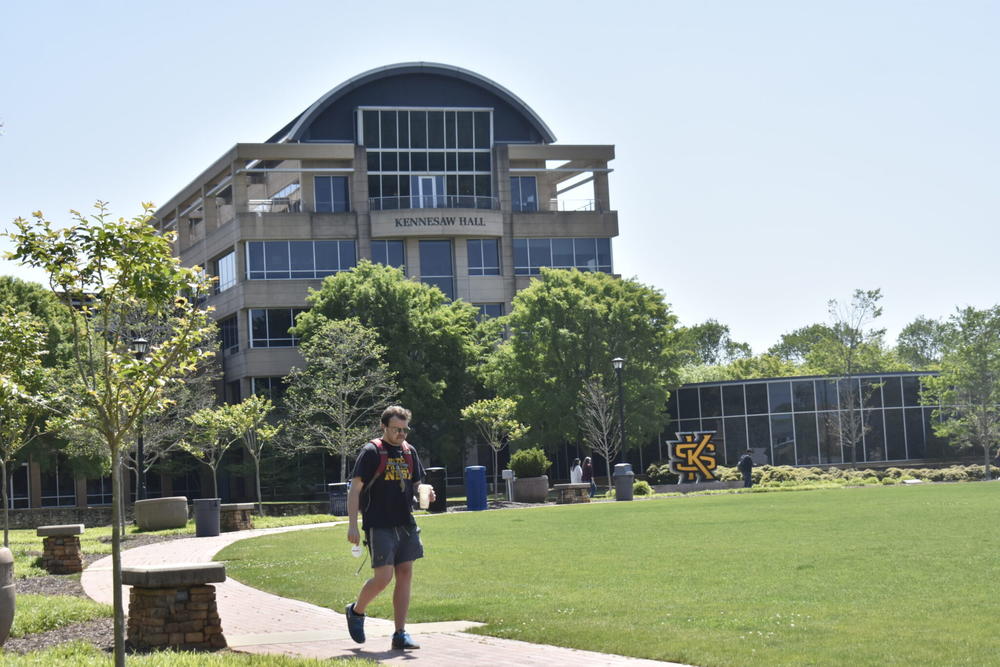
Caption
A student walks the Kennesaw State University campus. Universities such as Kennesaw allow high school students to sign up for college-level classes via dual enrollment programs.
Credit: Ross Williams/Georgia Recorder

A student walks the Kennesaw State University campus. Universities such as Kennesaw allow high school students to sign up for college-level classes via dual enrollment programs.
About 45,000 Georgia students participated in dual enrollment last year, taking college-level classes for both college and high school credit.
If those students were all packed into one district, they would be the eighth-largest district in the state, said Jennifer Phinney, dual enrollment program specialist at the Georgia Department of Education.
“It’s a significant population of our high school students around the state,” she said. “Almost every district in Georgia participated in dual enrollment last year. That includes our state charter schools and state schools in some capacities, they had student participation in dual enrollment as well. Our largest district participating in dual enrollment is Houston County, they had 2,707 students participating in dual enrollment. Taliaferro County had our smallest dual enrollment representation; they came in with eight.”
For some families of high school juniors and seniors, dual enrollment courses can be a way to save some money on tuition by banking college or technical school credit hours before their baby bird leaves the nest. But that money comes out of the state budget, and Georgia House members are spending the summer considering tweaks to the program. Their next meeting is scheduled for this Friday at the University of Georgia
In 2020, Gov. Brian Kemp signed a bill limiting state-sponsored dual enrollment options for Georgia students.
House Bill 444 capped the number of credit hours the state would fund per-student to 30, limited offerings to core academic courses and restricted the program to high school juniors and seniors with limited exceptions for sophomores.
Students can sign up for dual enrollment classes on their own dime to avoid these restrictions, but some lawmakers worried the changes would harm lower-income families.
Lawmakers approved the changes as a cost-limiting measure after a 2018 auditor’s report showed the program’s cost to the state ballooned from $18.5 million in 2014 to $78.8 million in 2018.
According to data from the Georgia Student Finance Commission, funding peaked at $104.6 million in 2019 and fell to $70.7 million in 2022.
Enrollment also fell between 2020 and 2021, with technical college and private students taking the biggest dip, while University System of Georgia enrollment stayed relatively level. The enrollment drop may be attributed to both the new law and the pandemic. The pandemic also shaped the way dual enrollment classes are delivered. Online classes made up just 12% of dual enrollment classes in 2020 before shooting up to 47% in 2021 and settling back to 29% in 2022.
Speaking to Phinney at a late August committee hearing, Rep. Chuck Martin, an Alpharetta Republican, questioned the expense and efficiency of the program.
“That’s what is of some concern to me, that the students are getting in the right place, we’re not just moving them to there so that we don’t have to teach them in high school. I’m going to say it. I mean, nobody wants to hear it, but that happens, I believe,” he said. “And again, you also talked about affordable, and respectfully, I think this is the most expensive education we deliver.”
Martin suggested that lowering costs would help students do more with their 30 hours of instruction and said he wants the committee to look for ways to streamline the program.
“Dual enrollment is a good thing, we’ve seen good aspects, but it’s paid for three times,” he said. “We pay a (full time equivalent) at the K through 12 level, we pay an FTE in TCSG or the university system, and then we pay the tuition at the rate that’s on that reading chart that President (Lynne) Riley gave us. So it’s very important, I think, for us to look at and maybe get data from the providers as what classes are being taken. Are we getting the students ahead toward a college degree or certification? Are we just replacing high school (courses) off campus with a course being taught at another geographic location?”
According to data from the University System of Georgia, the most popular dual enrollment courses for students seeking college credit are English composition 1, college algebra, English composition 2, American government and introduction to psychology. The university system’s data is from fall 2021.
Rep. Rick Jasperse, a Republican from Jasper, questioned whether some students taking dual enrollment might be just as well suited in advanced placement classes.
In 2022, 10% of students had dual enrollment as their only advanced course of study, 31% had only advanced placement classes or international baccalaureate and 14% had both.
“I would be curious on the years prior,” Jasperse said. “Because I think there’s been some discussion, or I’ve just heard people have talked to me about it, that dual enrollment is just undermining AP course enrollment. And I’d love to see the years prior to see if there’s a trend toward that, you know, because you have AP courses because of the in-depth study and just really advanced learning kids get. And are these swapping out? And is this program hurting enrollment in AP?”
Advanced placement classes and dual enrollment can both provide college credit to high schoolers, but they come with their own pros and cons for each individual student. For example, advanced placement students must pass an all-or-nothing test at the end of the semester to earn their college credit, and while dual enrollment classes may provide high schoolers with a taste of college life, a bad grade could be added to a student’s college GPA, which could come back and haunt them when they are seeking scholarships or applying to graduate programs.
This story comes to GPB through a reporting partnership with Georgia Recorder.